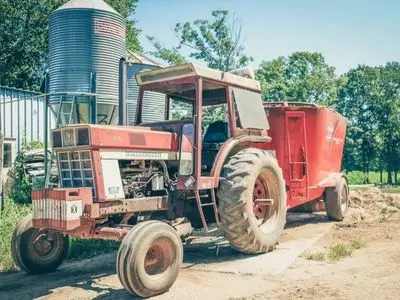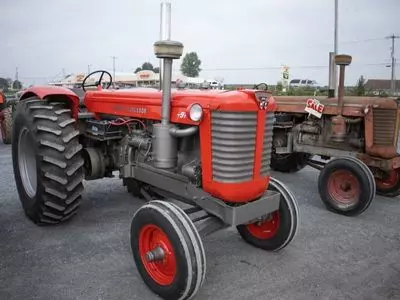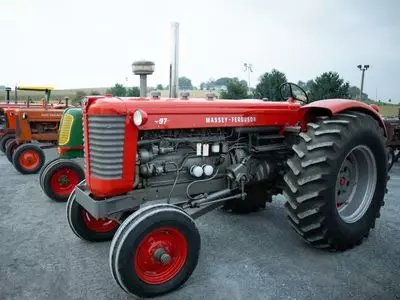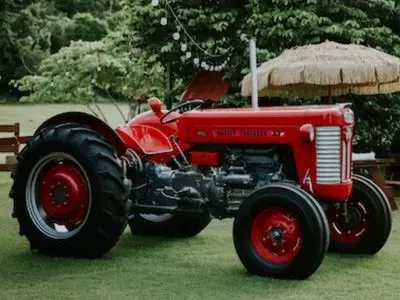No products in the cart.
Tractor
What Does PTO Stand For on a Tractor? – How it Works
PTOs are standard equipment on a wide range of commercial and agricultural vehicles.
Agriculture machinery such as wood chippers, harvesters, and hay balers are just a few of the many applications for PTOs in the hydraulic, pneumatic, and mechanical realms, but what does PTO stand for on a tractor?
‘PTO’ means “Power Take-Off.” A power take-off (PTO) is a mechanism that converts the mechanical energy created by an engine into another form. The host energy source may send power to auxiliary devices via a PTO.
The farmers of the past were crucial to the development of PTOs. Once, belt drives, attachments for drive shafts, and pneumatics like bleed air were commonplace in power takeoff systems.
Nowadays, most systems use a geared gearbox instead. Continue reading if you want to learn more about PTO.
*This post may have affiliate links, which means I may receive commissions if you choose to purchase through links I provide (at no extra cost to you). As an Amazon Associate I earn from qualifying purchases. Please read my disclaimer for additional details.
PTO Working On a Tractor

Power take-off, or PTO, is a device that transfers the mechanical energy produced by a vehicle’s engine to another piece of machinery.
The most common type of power take-off is the PTO shaft.
How the PTO Shaft Operates
The power take-off (PTO) shaft is an axle that the tractor’s motor spins. The other end of the shaft has a machine attached to it, like a lawnmower or snow thrower.
The power from the tractor’s engine goes to operate the attachment via the PTO shaft.
Because the tractor’s engine is used to drive the implement, PTO is effective.
The PTO shaft transfers power from the engine to the equipment. The machinery then utilizes this energy.
Here’s a video that covers what PTO is, the various types of PTO, and what they do:
A PTO can be either active (“living”) or inactive (“dead”).
PTO is referred to as “live PTO” when the tractor’s engine runs and the PTO shaft turns. When the tractor’s engine is switched off, and the PTO shaft isn’t turning, we refer to it as dead.
Mowers, snow blowers, pumps, and generators are only a few of the many devices that a PTO may drive.
PTOs are exposed and require delicate handling.
Always power off the machine and remove the keys before beginning maintenance to avoid injury. Be sure you know how to operate PTO attachments safely.
Read More: Best Backhoe Attachment for Tractor. A quality backhoe can be hard to find. We did the work for you, put the best-rated backhoe attachments to the test, and ranked them on how well they performed!
Tractor PTO Types

You might be wondering if PTO is only for certain tractors or if it applies to all tractors.
It’s reasonable to wonder whether every tractor you encounter will have a power takeoff (PTO), and the answer is that it’s likely.
Power takeoff (PTO) is a standard feature on most new tractors. It’s unusual to come across a tractor that doesn’t have a PTO. Despite their small size, compact tractors also include PTOs.
There are many types of PTOs, so it’s critical to know precisely what you’re searching for.
Some can operate for up to 10 hours daily, while others may only run for 10 minutes weekly. Ensure you understand the rated power output and how long the PTO can function before using one.
Transmission PTO
The name of this type of PTO originates from where it connects to the tractor. A tractor’s transmission has a spot for a PTO that is only powered when the gear is in use.
Transmission PTOs are basic, but have a simplistic design that can become overwhelmed and fail if you try to use them for a powerful implement.
Because the PTO is linked directly to the transmission, if the associated tools are heavy and tend to drive the tractor, this might cause potential damage to your machine.
Overrunning clutches is a safety measure in tractors. They kick in when the driven shaft starts rotating faster than the PTO shaft to prevent damage to the gearbox.
Live PTO
A live PTO can still deliver power to the equipment even if the gear is not engaged.
A separate clutch is required to activate and deactivate a live PTM instead of a transmission PTO.
Because a live PTO comes with a two-stage grip, the driver can shift gears or even shut off the tractor without disengaging the PTO.
The live PTO’s clutch cannot be engaged unless the tractor has stopped.
However, the PTO will not affect the tractor’s movement once it is engaging. A live PTO also has a benefit over transmission PTOS because while operating at high speeds, there is less wear and tear on both transmissions.
Independent PTO
The benefits of live PTO and independent PTO are easy to see. Thanks to its clutch, the PTO can be activated independently of the gear.
This means that any part of the tractor can be used without having to worry about whether the rest of the machine is in motion or not.
Similarly, deactivating the PTO is also something that can be done at any time and does not require shutting down the whole tractor first.
There are two different types of PTOs: hydraulic and mechanical. They can both be turned on and off with an electrical switch.
The mechanically autonomous version features an additional lever clutch in addition to the existing electrical control. With the safety lever, a worker can’t accidentally activate the PTO.
The PTO can work even if the car is in Park, Neutral, or Drive, so the driver has the chance to make this decision whenever they want.
Even though an independent PTO usually won’t damage the tractor’s transmission, it could still be damaged if a driver uses it often while driving quickly.
While most operators love autonomous PTO for its convenience, some misuse it. The enormous output of an independent PTO makes it ideal for continuous operations.
Using the PTO correctly may extend the life of the tractor and its attachments for years.
Read More: Best Post Hole Digger for Tractor. We tried out the top post hole digger tractor attachments. Here are our favorites, why we like them, why we don’t, and a guide on how to choose the right one for your needs!
Guidelines for Safely Using the PTO on a Tractor

Accidents caused by the PTO shafts of a tractor resulting in severe injuries are not uncommon. This shaft may be extended by sliding one part on top of another.
These unplanned separations don’t happen very frequently, however, the PTO shaft can come out if the hitch isn’t properly installed.
Precautions for Using a PTO
When the hitch separates or breaks, the shaft may become dislodged. As a result, this hazard must be considered whenever PTO is utilized; otherwise, it might lead to injury.
When using PTO, there are some precautions you can take to avoid unintentional disentanglement and separation:
- Maintaining a secure and protected environment for the parts of your PTO system is imperative.
- Before you start the engine, check that your driveline guards are unobstructed and not spinning or turning. This will keep the PTO shaft from getting snagged on the guards.
- Before turning your tractor on, get in the habit of walking around it to give it a once-over. You should also check that all the attachments are secure.
- Make sure you keep the drivelines that come with your equipment. It would help if you did not alter the driveline direction.
- When working on the tractor, ensure the PTO is disengaged, and the engine is switched off. If you do this consistently, it’ll be easier to maintain or repair your equipment whenever necessary.
- Don’t mistreat the PTO shaft, and use it as intended. This includes avoiding sharp curves and minimizing telescoping. Start the PTO shaft motor slowly also to maintain longevity. The clutches shouldn’t be too tight, making the machinery sluggish.
- When setting up the drawbar on a system, do it correctly. By reducing the strain on the driveline and lowering the risk of it coming free while going over rough ground and making sharp turns, you can reduce this danger.
- The PTO driveline of your tractor should be securely attached to the tractor’s PTO stub shaft. Consult the user handbook or seek expert assistance to guarantee that your universal joints operate in phase.
Conclusion
The PTO, or Power take-off, is crucial for the transference of power from the engine to whatever attachment you may need. Hopefully, this article has helped you to understand how it works and how to maintain it safely.

